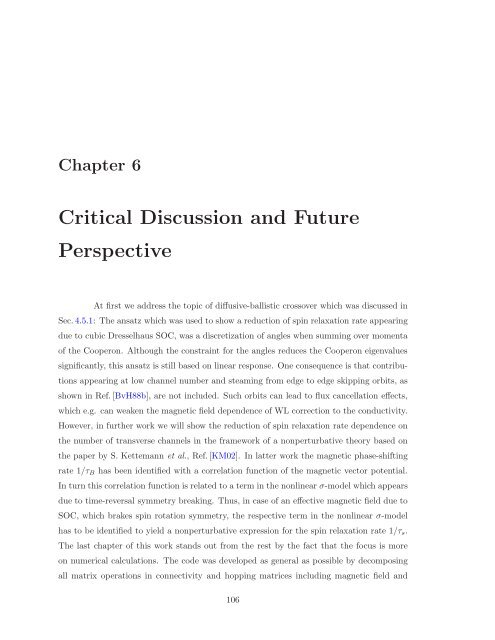Itinerant Spin Dynamics in Structures of ... - Jacobs University
Itinerant Spin Dynamics in Structures of ... - Jacobs University
Itinerant Spin Dynamics in Structures of ... - Jacobs University
You also want an ePaper? Increase the reach of your titles
YUMPU automatically turns print PDFs into web optimized ePapers that Google loves.
Chapter 6<br />
Critical Discussion and Future<br />
Perspective<br />
At first we address the topic <strong>of</strong> diffusive-ballistic crossover which was discussed <strong>in</strong><br />
Sec.4.5.1: The ansatz which was used to show a reduction <strong>of</strong> sp<strong>in</strong> relaxation rate appear<strong>in</strong>g<br />
due to cubic Dresselhaus SOC, was a discretization <strong>of</strong> angles when summ<strong>in</strong>g over momenta<br />
<strong>of</strong> the Cooperon. Although the constra<strong>in</strong>t for the angles reduces the Cooperon eigenvalues<br />
significantly, this ansatz is still based on l<strong>in</strong>ear response. One consequence is that contributions<br />
appear<strong>in</strong>g at low channel number and steam<strong>in</strong>g from edge to edge skipp<strong>in</strong>g orbits, as<br />
shown <strong>in</strong> Ref.[BvH88b], are not <strong>in</strong>cluded. Such orbits can lead to flux cancellation effects,<br />
which e.g. can weaken the magnetic field dependence <strong>of</strong> WL correction to the conductivity.<br />
However, <strong>in</strong> further work we will show the reduction <strong>of</strong> sp<strong>in</strong> relaxation rate dependence on<br />
the number <strong>of</strong> transverse channels <strong>in</strong> the framework <strong>of</strong> a nonperturbative theory based on<br />
the paper by S. Kettemann et al., Ref.[KM02]. In latter work the magnetic phase-shift<strong>in</strong>g<br />
rate 1/τ B has been identified with a correlation function <strong>of</strong> the magnetic vector potential.<br />
In turn this correlation function is related to a term <strong>in</strong> the nonl<strong>in</strong>ear σ-model which appears<br />
due to time-reversal symmetry break<strong>in</strong>g. Thus, <strong>in</strong> case <strong>of</strong> an effective magnetic field due to<br />
SOC, which brakes sp<strong>in</strong> rotation symmetry, the respective term <strong>in</strong> the nonl<strong>in</strong>ear σ-model<br />
has to be identified to yield a nonperturbative expression for the sp<strong>in</strong> relaxation rate 1/τ s .<br />
The last chapter <strong>of</strong> this work stands out from the rest by the fact that the focus is more<br />
on numerical calculations. The code was developed as general as possible by decompos<strong>in</strong>g<br />
all matrix operations <strong>in</strong> connectivity and hopp<strong>in</strong>g matrices <strong>in</strong>clud<strong>in</strong>g magnetic field and<br />
106
















